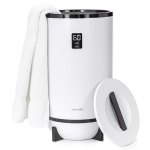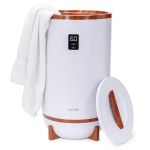Should you choose wall or ceiling speakers?
What are wall and ceiling speakers and when would you use them?
Wall and ceiling speakers are a great addition to any home theatre or to provide music or audio in a single room.
Wall speakers fit in-wall or sit on-wall while ceiling speakers tend to fit flush in the ceiling for an unobtrusive design.
They are usually square, rectangular, or circular with different specs based on your needs, the size of the room, and how many other speakers you have set up. Colours include white, black, and brown, and some even have paintable grills so they can blend seamlessly. Some are moisture-resistant, ideal for a bathroom, and some are weatherproof for outdoor audio. They are sold individually or in pairs and premium models add neat features like voice control capability.
Depending on the speaker and room, wall speakers are ideal for surround sound set-ups in a home theatre or primary listening room, and for stereo sound, while ceiling speakers are great for multi-room or immersive sound, adding sound from above which is especially useful in 360-degree immersive audio set-ups, like Dolby Atmos.
What is the difference between wall and ceiling speakers?
Generally, wall and ceiling speakers are similar. Wall speakers provide lifelike, accurate sound and because they fit on (or in) the wall, they can save space. Ceiling speakers, on the other hand, are great for larger speaker set-ups or to extend sound to a smaller area like a bathroom or hallway.
Wall speakers are usually square or rectangle while ceiling speakers are often round, mimicking the look of typical light fixtures.
When you get into higher end models, you may notice a different in how they are designed for sound. Wall speakers tend to have front-firing woofers that are pointed horizontally across the room to create sound where you want it most while ceiling speakers are mounted for down-firing sound from the ceiling above.
How many do you need and where should you place them?
How many wall or ceiling speakers you need depends on a variety of factors, like where you are placing them and why.
Generally, in a mid-to-large room, you'd want from 2-4 stereo pairs of wall speakers, though some single speakers will be sufficient to meet your needs for background music. You might need fewer if they are being used for additional channels in a room where you already have tower speakers and a centre channel speaker, for example.
With a speaker in ceiling set-up, 1-2 might be sufficient for background music. But if you plan on entertaining, you might want up to 6 throughout a room so you can achieve the optimal volume, especially if the room has high ceilings. In a smaller room like a powder room or office, however, a single ceiling speaker will do.
Space them out to provide all-encompassing sound. When adding them for immersive audio in a home theatre, you want left and right channels as well as rear left and right, and maybe up above. Position them at ear level, such that the audio is directed to the listening sweet spot. Some ceiling speakers have rotating tweeters so you can direct the sound as desired once they are set up.
For in-wall or in-ceiling speakers, make sure there is room for the backboxes so they can sit flush.
If you're unsure about placement, consult a professional who can map out your room and provide insight. If you're buying in-wall or in-ceiling speakers, you might want a professional to handle the installation anyway.




